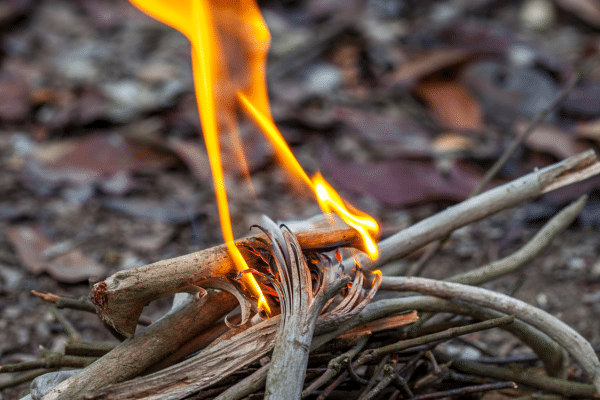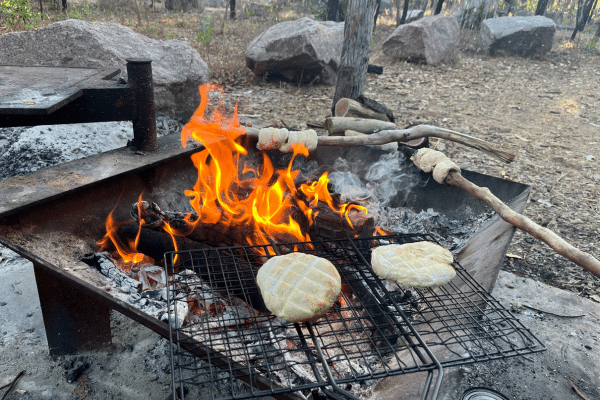06 Nov Embarking on Outdoor Adventures: A Beginner’s Guide to Bushcraft
 Are you ready to dive into the exciting world of outdoor exploration? Well, get ready to learn about an awesome skillset called bushcraft.
Are you ready to dive into the exciting world of outdoor exploration? Well, get ready to learn about an awesome skillset called bushcraft.
It’s all about surviving and thriving in the wilderness using minimal tools and resources. Let’s get started on your bushcraft journey!
What is bushcraft? So, what exactly is bushcraft? It’s the art of living comfortably in the great outdoors with limited resources. Instead of relying on fancy gadgets, you’ll use your knowledge and skills to connect with nature and find shelter, food, and water. It’s like going back to basics and becoming one with the wilderness.
Learning bushcraft skills has tons of benefits, even if you’re not planning on being the next Bear Grylls. It gives you a sense of independence and self-sufficiency.
Plus, it’s super cool to learn practical skills that can come in handy in all sorts of situations. And let’s not forget how amazing it feels to spend time in nature and explore the wild!
Essential Skills for Beginners
Knife Skills and Tool Selection One of the most important skills in bushcraft is knowing how to use a knife and pick the right tools. A good knife is like your trusty sidekick in the wilderness. It helps you with carving, cutting, and preparing food. Safety always comes first, so make sure you learn how to handle a knife properly and take care of your tools.
Knot Tying and Rope Work Knowing how to tie knots is not only a must for climbing but also for building shelters, securing gear, and creating makeshift tools. Start with a few basic knots like the bowline, square knot, and clove hitch. With some rope and a little know-how, you’ll be able to solve all sorts of problems like a real-life MacGyver!
Understanding and Using a Compass Getting lost in the woods can be scary, but fear not! Learning how to use a compass is a valuable skill that will keep you on track and help you find your way back. Get familiar with the basics of navigation, map reading, and orienteering. Soon enough, you’ll be confidently exploring the wilderness like a pro.
Building Shelter in the Wilderness
Shelter Types and Construction Techniques When it comes to shelter in the wilderness, you’ve got options! From simple lean-tos and tarp setups to more complex debris huts, there are different techniques to keep you dry and protected from the elements. Start with the basics and gradually expand your knowledge as you gain experience.
Natural Materials for Shelter Building Nature is your best friend when it comes to finding materials for shelter construction. Learn to identify suitable materials like branches, leaves, and bark. It’s like playing real-life Minecraft, but instead of cubes, you’re using branches and leaves to create your cozy hideaway.
Tips for Sleeping Comfortably in the Outdoors A good night’s sleep is crucial, even when camping in the wild. Master the art of comfort by using insulation from the ground, creating a cozy bedding of leaves or pine needles, and ensuring proper ventilation. A well-rested adventurer is always ready for the next day’s exciting adventures!
Survival Skills for Middle Schoolers: Finding Water and Cooking Over a Campfire
 When you’re out in the wild, finding clean water is super important for your survival. Let’s learn how to find and purify water so you can stay hydrated and healthy.
When you’re out in the wild, finding clean water is super important for your survival. Let’s learn how to find and purify water so you can stay hydrated and healthy.
Identifying Reliable Water Sources First things first, we need to know where to find clean water. Look out for flowing streams, natural springs, or even collect rainwater. But be careful! Avoid stagnant water or sources near animal waste, as they can make you sick.
Water Collection and Filtration Methods Once you’ve found water, it’s time to collect it safely. You can use containers, tarps, or even big leaves to gather and store water for later. But wait! If the water looks cloudy or smells weird, it’s a good idea to filter it. You can do this by boiling it, using portable filters, or chemical water treatments.
Boiling and Disinfecting Water for Safe Consumption Boiling water is a fantastic way to kill harmful bacteria and parasites. Just bring the water to a rolling boil for at least one minute (or three minutes if you’re at a higher elevation). Another option is to use water purification tablets or iodine to disinfect the water quickly.
Remember, bushcraft is all about hands-on learning. So get out there, practice these skills, and have fun! Don’t worry if you make mistakes along the way, that’s part of the adventure. And always remember to respect nature and leave no trace behind.
Firecraft and Campfire Cooking
 Now, let’s talk about something exciting – campfires! There’s nothing better than gathering around a cozy fire with your friends and family. But first, you need to know how to build a fire properly.
Now, let’s talk about something exciting – campfires! There’s nothing better than gathering around a cozy fire with your friends and family. But first, you need to know how to build a fire properly.
Fire Building Techniques There are a few different ways to build a fire, like the teepee, log cabin, and lean-to methods. Each has its own strengths and can work better in different weather conditions. Try them out and see which one you like best. You’ll become a fire-starting pro in no time!
Gathering and Preparing Firewood When it comes to firewood, remember the three Ws: wood, weather, and willingness. Look for dry wood that snaps easily because damp wood can be tough to ignite. Be responsible and gather dead branches or fallen trees without damaging the environment.
Once you have your firewood, it’s time to prepare it for burning. Use a saw or axe to break larger pieces into smaller sizes. And don’t forget to gather kindling, like dry twigs and birch bark, to help get your fire started.
Cooking Methods and Recipes Now that you know how to build a fire, it’s time to cook some delicious food! Cooking outdoors can be so much fun once you know the basics.

You can start with simple campfire classics like smores and damper on sticks. But if you’re feeling adventurous, try cooking more elaborate meals in cast iron pots or Dutch ovens. There are endless camping recipes to explore, so find ones that suit your taste and dietary preferences. Just remember to pack the right cooking utensils and always prioritize food safety.
Survival Skills for Outdoor Adventures
Navigation Techniques and Basic Survival Tools Getting lost in the wilderness can be a bummer for any adventurer. That’s why it’s important to know how to navigate and read maps. Take some time to learn about topographic maps and how to use a compass. These skills will help you find your way, even in unfamiliar places.
When you’re out in the great outdoors, make sure you have the right tools to handle unexpected challenges. Some essential items to pack include a multi-tool, a reliable flashlight, a first aid kit, and a sturdy knife. These tools can be super useful for setting up camp and dealing with emergencies.
Emergencies are no fun, but being prepared can make a big difference. Learn basic signaling techniques, like using a whistle or mirror, to attract attention if you need help. It’s also a good idea to bring a portable communication device, such as a satellite phone or locator beacon, for extra peace of mind.
Edible Plants and Wilderness Foraging Foraging for edible plants in the wilderness can be a fun and tasty adventure! But before you start munching on random greens, it’s important to know what you’re doing. Learn how to identify common edible plants in your area, like dandelions or wild berries. You can also carry a field guide or take a foraging class to boost your confidence.
While it’s exciting to find food in nature, it’s equally important to know which plants are harmful or inedible. Stay away from plants with thorns, milky sap, or strong odors, as these can be warning signs. When in doubt, it’s better to be hungry than to end up with a stomachache!
When you’re foraging, it’s crucial to be sustainable. Only take what you need, so the plants and their ecosystem can survive. Avoid picking endangered or protected species and be mindful of your impact on the environment. Let’s be responsible adventurers and ensure that future generations can also enjoy nature’s edible treasures.
Discover the Adventure of Bushcraft
Safety and Leave No Trace Principles When you’re out exploring the wilderness, safety should always be your top priority. It’s important to learn basic first aid techniques and carry a well-stocked first aid kit. Be aware of potential hazards like encounters with wildlife or sudden weather changes, and take the necessary precautions. Remember, a safe adventure is a successful adventure.
As outdoor enthusiasts, it’s our responsibility to preserve and protect nature for future generations. That’s where the Leave No Trace principles come in. These principles encourage us to leave the wilderness as we found it. Practice proper waste disposal, respect wildlife and their habitats, and minimize your impact on delicate ecosystems. Let’s keep our wild spaces pristine and beautiful for everyone to enjoy.
Now that you have a taste of these bushcraft ideas, it’s time to grab your gear, venture into the great outdoors, and embrace the wild side of life. Just remember, while bushcraft skills are valuable, it’s the experiences and memories you create that truly ignite the adventurer within. Happy exploring!
FAQ
Is bushcraft suitable for beginners? Yes, bushcraft is highly accessible for beginners. It offers practical skills and knowledge that can be learned and developed over time. With proper guidance and practice, beginners can quickly grasp essential bushcraft techniques and apply them to their outdoor adventures.
Do I need any specialized equipment to start learning bushcraft While there are specific tools and equipment that can enhance your bushcraft experience, such as a reliable knife, compass, and fire-starting tools, they are not absolutely necessary for beginners. One of the fundamental principles of bushcraft is utilizing the resources available in nature. So, starting with the basics and gradually adding equipment as you progress is a perfectly viable approach.
Are there any safety considerations to keep in mind while practicing bushcraft? Absolutely. Safety should always be a top priority when engaging in any outdoor activity. It is crucial to be aware of potential hazards, have a first aid kit on hand, and inform someone about your plans and expected return time. Additionally, learning about local wildlife, weather patterns, and emergency signaling techniques can help ensure a safe and enjoyable bushcraft experience.
Can bushcraft skills be applied in everyday life? Indeed, bushcraft skills are not limited to wilderness settings but can also be applied in everyday life. Basic survival techniques, such as fire building, knot tying, and navigation, can prove useful in various situations, including camping trips, bushwalking adventures, or even unexpected emergencies. Moreover, bushcraft fosters a deeper connection to nature and encourages self-sufficiency, which can positively impact our daily lives and mindset.

